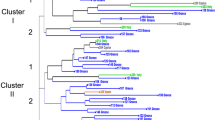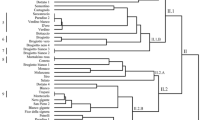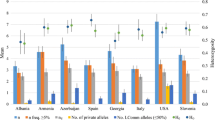Abstract
Ficus carica L., the common fig, is a Mediterranean crop with ambiguous cultivar identification. This fruit is of great importance worldwide, being able to be implanted as a new source of agricultural variability. Therefore, the genetic characterization of the available germplasm is involved in restoring and protecting potential local varieties for ecological agriculture. The assessment of the genetic variability of fig is a key tool for the selected programs to identify varieties that could be used as natural sources of attracting bioactive compounds that may have an array of potential applications. Hybridization, local adaptation, clinal variation, and recurrent colonization episodes contribute to genetic variability. Thus, autogamous species invasion resulted in genetically homogeneous populations. Genetical diversity of fig is also critical for predicting its future dispersal in the face of global climate change. From that perspective, the current knowledge of the genetic variability of Ficus carica L. is reviewed in this chapter. Fingerprinting was done on various samples, including local varieties, caprifigs, and reference samples. Therefore, many approaches have been employed in DNA fingerprinting of the Ficus carica L., including PCR-RFLP fingerprinting, SSR, and Microsatellite markers as efficient methods to evaluate the fig tree diversity. It was concluded that the most divergent accessions presented characteristics of agronomic interest, allowing the selection of features to subsidize conservation works, genetic improvement, and crop production.
Access this chapter
Tax calculation will be finalised at checkout
Purchases are for personal use only
Similar content being viewed by others
Abbreviations
- AMOVA:
-
Molecular Variance Analysis
- ANOVA:
-
Analysis of variance
- GO:
-
Genetic Ontology
- ISSR:
-
Inter-Simple Sequence Repeats
- Itraq:
-
Isobaric Tags for Relative and Absolute Quantitation
- LTR:
-
Long Terminal Repeat
- NCGR:
-
National Clonal Germplasm Repository
- PCA:
-
Principal Component Analysis
- PCR:
-
Polymerase Chain Reaction
- RAPD:
-
Random Amplified Polymorphism DNA
- RFLP:
-
Restriction Fragment Length Polymorphism
- SAS:
-
Statistical Analysis System
- SSR:
-
Simple-Sequence Repeats
- UPGMA:
-
Unweighted Pair-Group Approach of Arithmetic Averages
References
Ahmad, S., Bhatti, F. R., Khaliq, F. H., Irshad, S., & Madni, A. (2013). A review on the prosperous phytochemical and pharmacological effects of Ficus carica. International Journal of Bioassays, 2(5), 843–849.
Ahmed, B. A., Ghada, B., Laila, E., Hafid, A., Bouchaib, K., & Amel, S. H. (2015). Use of morphological traits and microsatellite markers to characterize the Tunisian cultivated and wild figs (Ficus carica L.). Biochemical Systematics and Ecology, 59, 209–219.
Aljane, F. (2011). Caractérisation et évaluation des accessions locales de figuier (Ficus carica L,) en Tunisie et sélection des plus performantes (Doctoral dissertation, Thèse de doctorat, Faculté des Sciences).
Amessis-Ouchemoukh, N., Ouchemoukh, S., Meziant, N., Idiri, Y., Hernanz, D., Stinco, C. M., Rodríguez-Pulido, J. R., Heredia, J. F., Madani, K., & Luis, J. (2017). Bioactive metabolites involved in the antioxidant, anticancer and anticalpain activities of Ficus carica L., Ceratonia siliqua L. and Quercus ilex L. extracts. Industrial Crops and Products, 95, 6–17.
Barolo, M. I., Mostacero, N. R., & López, S. N. (2014). Ficus carica L. (Moraceae): An ancient source of food and health. Food Chemistry, 164, 119–127.
Berg, C. C. (2003). Flora Malesiana precursor for the treatment of Moraceae 1: The main subdivision of Ficus: The subgenera. Blumea-Biodiversity, Evolution and Biogeography of Plants, 48(1), 166–177.
Boudchicha, R. H. (2019). Etude de la diversité génétique de quelques variétés locales de figuier (Ficus carica L.) en Algérie. Doctoral dissertation, Université de Batna 2
Çalişkan, O., & Polat, A. A. (2012). Morphological diversity among fig (Ficus carica L.) accessions sampled from the eastern Mediterranean region of Turkey. Turkish Journal of Agriculture and Forestry, 36(2), 179–193.
Chai, L., Wang, Z., Chai, P., Chen, S., & Ma, H. (2017). Transcriptome analysis of San Pedro-type fig (Ficus carica L.) parthenocarpic breba and non-parthenocarpic main crop reveals divergent phytohormone-related gene expression. Tree Genetics & Genomes, 13(4), 1–14.
Chatti, K., Salhi-Hannachi, A., Mars, M., Marrakchi, M., & Trifi, M. (2004). Analyse de la diversité génétique de cultivars tunisiens de figuier (Ficus carica L.) à l’aide de caractères morphologiques. Fruits, 59(1), 49–61.
Condit, I. J. (1933). Fig culture in California (Vol. 77). Рипол Классик.
Corner, E. J. H. (1965). Check-list of Ficus in Asia and Australasia with keys to identification. Garden’s Bulletin Singapore, 21, 1–186.
Darjazi, B. B. (2011). Morphological and pomological characteristics of fig (Ficus carica L.) cultivars from Varamin, Iran. African Journal of Biotechnology, 10(82), 19096–19105.
Deng, P., Wang, M., Feng, K., Cui, L., Tong, W., Song, W., & Nie, X. (2016). Genome-wide characterization of microsatellites in Triticeae species: Abundance, distribution and evolution. Scientific Reports, 6(1), 1–13.
Devos, K. M., Brown, J. K., & Bennetzen, J. L. (2002). Genome size reduction through illegitimate recombination counteracts genome expansion in Arabidopsis. Genome Research, 12(7), 1075–1079.
Dubin, M. J., Scheid, O. M., & Becker C. (2018). Transposons: A blessing curse. Current Opinion in Plant Biology, 42, 23–29.
Engelmann, F. (2000). Importance of cryopreservation for the conservation of plant genetic resources. In Cryopreservation of tropical plant germplasm—Current research progress and applications, IPGRI, Rome & JIRCAS (pp. 8–20)
Essid, A., Aljane, F., Ferchichi, A., & Hormaza, J. I. (2015). Analysis of genetic diversity of Tunisian caprifig (Ficus carica L.) accessions using simple sequence repeat (SSR) markers. Hereditas, 152(1), 1–7.
Fabres, P. J., Collins, C., Cavagnaro, T. R., & Rodríguez López, C. M. (2017). A concise review on multi-omics data integration for terroir analysis in Vitis vinifera. Frontiers in Plant Science, 8, 1065.
Ferguson, L., Michailides, T. J., & Shorey, H. H. (1990). The California fig industry. Horticultural reviews (USA).
Figueiredo, P., & Pinheiro, E. D. (1969). Uma nova doença da figueira (Ficus carica L.) na região de Valinhos, SP. Biológico, 35, 227–203.
Freiman, Z. E., Doron-Faigenboim, A., Dasmohapatra, R., Yablovitz, Z., & Flaishman, M. A. (2014). High-throughput sequencing analysis of common fig (Ficus carica L.) transcriptome during fruit ripening. Tree Genetics & Genomes, 10(4), 923–935.
Gafoor, H., Bhattacharjee, A., Hegde, K., & Shabaraya, A. R. (2019). Ficus carica: A brief review. International Journal of Pharmaceutical Sciences Review and Research, 59(2), 40–43.
Gibernau, M., Buser, H. R., Frey, J. E., & Hossaert-McKey, M. (1997). Volatile compounds from extracts of figs of Ficus carica. Phytochemistry, 46(2), 241–244.
Hosomi, A. (2015). Variation in graft compatibility of wild Ficus species as rootstock for common fig trees (Ficus carica). V International Symposium on Fig, 1173, 199–206.
Ikegami, H., Nogata, H., Hirashima, K., Awamura, M., & Nakahara, T. (2009). Analysis of genetic diversity among European and Asian fig varieties (Ficus carica L.) using ISSR, RAPD, and SSR markers. Genetic Resources and Crop Evolution, 56(2), 201–209.
Ikegami, H., Habu, T., Mori, K., Nogata, H., Hirata, C., Hirashima, K., Tashiro, K., & Kuhara, S. (2013). De novo sequencing and comparative analysis of expressed sequence tags from gynodioecious fig (Ficus carica L.) fruits: Caprifig and common fig. Tree Genetics & Genomes, 9(4), 1075–1088.
IPGRI & CIHEAM. (2003). Descriptors for figs. International Plant Genetic Resources Institute (IPGRI) and the International Centre for Advanced Mediterranean Agronomic Studies (CIHEAM).
Joseph, B., & Raj, S. J. (2011). Pharmacognostic and phytochemical properties of Ficus carica Linn-an overview. International journal of pharmtech research, 3(1), 8–12.
Khadari, B., Lashermes, P., & Kjellberg, F. (1994). Identification variétale et ressources génétiques chez le figuier (Ficus carica L.): utilisation des marqueurs RAPD. AUPELF-UREF.
Khadhraoui, M., Bagues, M., Artés, F., & Ferchichi, A. (2019). Phytochemical content, antioxidant potential, and fatty acid composition of dried Tunisian fig (Ficus carica L.) cultivars. Journal of Applied Botany and Food Quality, 92, 143–150.
Khadivi, A., Anjam, R., & Anjam, K. (2018). Morphological and pomological characterization of edible fig (Ficus carica L.) to select the superior trees. Scientia Horticulturae, 238, 66–74.
Lahbib, T. (1984). Etude pomologique des variétés de figuier (Ficus carica L.) répertoriées au Sahel tunisien. Mémoire de Fin d’Études du Cycle de Spécialisation.
Lisch, D. (2013). How important are transposons for plant evolution? Nature Reviews Genetics, 14(1), 49–61.
Mars, M., Chatti, K., Saddoud, O., Salhi-Hannachi, A., Trifi, M., & Marrakchi, M. (2008). Fig cultivation and genetic resources in Tunisia, an overview. Acta Horticulturae, 798, 27–32.
Mawa, S., Husain, K., & Jantan, I. (2013). Ficus carica L.(Moraceae): Phytochemistry, traditional uses and biological activities. Evidence-Based Complementary and Alternative Medicine.
Miličević, B., Ačkar, Đ., Babić, J., Jozinović, A., Oroz, M., & Šubarić, D. (2017). Impact of the fermentation process with immobilized yeast cells on the aroma profile and sensory quality of distillates produced from two fig (Ficus carica L.) cultivars. Poljoprivreda, 23(1), 49–55.
Miyagi, M., & Rao, K. S. (2007). Proteolytic 18O-labeling strategies for quantitative proteomics. Mass Spectrometry Reviews, 26(1), 121–136.
Padden, J., Megger, D. A., Bracht, T., Reis, H., Ahrens, M., Kohl, M., Eisenacher, M., Schlaak, J. F., Canbay, A. E., Weber, F., Hoffmann, A. C., Kuhlmann, K., Meyer, H. E., Baba, H. A., & Sitek, B. (2014). Identification of novel biomarker candidates for the immunohistochemical diagnosis of cholangiocellular carcinoma. Molecular & Cellular Proteomics, 13(10), 2661–2672.
Palma, J. M., Corpas, F. J., & Luís, A. (2011). Proteomics as an approach to the understanding of the molecular physiology of fruit development and ripening. Journal of Proteomics, 74(8), 1230–1243.
Panis, B., Swennen, R., & Engelmann, F. (2000, July). Cryopreservation of plant germplasm. In IV International Symposium on In Vitro Culture and Horticultural Breeding, 560 (pp. 79–86).
Pereira, C., Serradilla, M. J., Martín, A., del Carmen Villalobos, M., Pérez-Gragera, F., & López-Corrales, M. (2015). Agronomic behaviour and quality of six fig cultivars for fresh consumption. Scientia Horticulturae, 185, 121–128.
Pereira, C., Serradilla, M. J., Pérez-Gragera, F., Martín, A., Villalobos, M. C., & López-Corrales, M. (2017). Evaluation of agronomic and fruit quality traits of fig tree varieties (Ficus carica L.) grown in Mediterranean conditions. Spanish Journal of Agricultural Research, 15(3), e0903–e0903.
Pierre, B. (1959). La greffe, important facteur de l’augmentation du rendement des plantes et des animaux. IMPACT science et société, IX, n 3.
Podgornik, M., Vuk, I., Vrhovnik, I., & Mavsar, D. B. (2010). A survey and morphological evaluation of fig (Ficus carica L.) genetic resources from Slovenia. Scientia Horticulturae, 125(3), 380–389.
Raskovic, B., Lazic, J., & Polovic, N. (2016). Characterisation of general proteolytic, milk clotting and antifungal activity of Ficus carica latex during fruit ripening. Journal of the Science of Food and Agriculture, 96(2), 576–582.
Rodríguez-Solana, R., Galego, L. R., Pérez-Santín, E., & Romano, A. (2018). Production method and varietal source influence the volatile profiles of spirits prepared from fig fruits (Ficus carica L.). European Food Research and Technology, 244(12), 2213–2229.
Roger, J. P. (2003). L’origine des arbres fruitiers. Conservatoire botanique national méditerranéen de Porquerolles. Antenne Provence-Alpes, Côte d’Azur.
Saddoud, O., Salhi-Hannachi, A., Chatti, K., Mars, M., Rhouma, A., Marrakchi, M., & Trifi, M. (2005). Tunisian fig (Ficus carica L.) genetic diversity and cultivar characterization using microsatellite markers. Fruits, 60(2), 143–153.
Sahin, N. (1997, June). Fig adaptation studies in Western Turkey. In I International Symposium on Fig, 480 (pp. 61–70).
Salem, M. Z., Salem, A. Z. M., Camacho, L. M., & Ali, H. M. (2013). Antimicrobial activities and phytochemical composition of extracts of Ficus species: An overview. African Journal of Microbiology Research, 7(33), 4207–4219.
Smartt, J. (1976). Evolution of crop plants (pp. 205–208). Longman.
Soni, N., Mehta, S., Satpathy, G., & Gupta, R. K. (2014). Estimation of nutritional, phytochemical, antioxidant and antibacterial activity of dried fig (Ficus carica). Journal of Pharmacognosy and Phytochemistry, 3(2), 158–165.
Sun, Y. V., & Hu, Y. J. (2016). Integrative analysis of multi-omics data for discovery and functional studies of complex human diseases. Advances in Genetics, 93, 147–190.
Towill, L. E., & Bajaj, Y. P. S. (2002). Biotechnology in agriculture and forestry. Cryopreservation of plant germplasm II.
Trad, M., Ginies, C., Gaaliche, B., Renard, C. M., & Mars, M. (2012). Does pollination affect aroma development in ripened fig (Ficus carica L.) fruit? Scientia Horticulturae, 134, 93–99.
Usai, G., Mascagni, F., Giordani, T., Vangelisti, A., Bosi, E., Zuccolo, A., Ceccarelli, M., King, R., Hassani-Pak, K., Zambrano, L. S., Cavallini, A., & Natali, L. (2020). Epigenetic patterns within the haplotype phased fig (Ficus carica L.) genome. The Plant Journal, 102(3), 600–614.
Valarini, P. J., & Tokeshi, H. (1980). Ceratocystis fimbriata, causal agent of fig dieback, and its control. Summa Phytopathologica, 6(3/4), 102–106.
Vangelisti, A., Simoni, S., Usai, G., Ventimiglia, M., Natali, L., Cavallini, A., Mascagni, F., & Giordani, T. (2021). LTR-retrotransposon dynamics in common fig (Ficus carica L.) genome. BMC Plant Biology, 21(1), 1–18.
Wang, T., Jiao, J., Gai, Q. Y., Wang, P., Guo, N., Niu, L. L., & Fu, Y. J. (2017). Enhanced and green extraction polyphenols and furanocoumarins from fig (Ficus carica L.) leaves using deep eutectic solvents. Journal of Pharmaceutical and Biomedical Analysis, 145, 339–345.
Ware, A. B., Kaye, P. T., Compton, S. G., & Van Noort, S. (1993). Fig volatiles: Their role in attracting pollinators and maintaining pollinator specificity. Plant Systematics and Evolution, 186(3), 147–156.
Wojdyło, A., Nowicka, P., Carbonell-Barrachina, Á. A., & Hernández, F. (2016). Phenolic compounds, antioxidant and antidiabetic activity of different cultivars of Ficus carica L. fruits. Journal of Functional Foods, 25, 421–432.
Yakushiji, H., Morita, T., Jikumaru, S., Ikegami, H., Azuma, A., & Koshita, Y. (2012). Interspecific hybridization of fig (Ficus carica L.) and Ficus erecta Thunb., a source of Ceratocystis canker resistance. Euphytica, 183(1), 39–47.
Author information
Authors and Affiliations
Corresponding author
Editor information
Editors and Affiliations
Rights and permissions
Copyright information
© 2023 The Author(s), under exclusive license to Springer Nature Switzerland AG
About this chapter
Cite this chapter
Ben Abdallah, R., Othmani, I., Lagha, A., Fattouch, S. (2023). Genetic Diversity of Fig Varieties. In: Ramadan, M.F. (eds) Fig (Ficus carica): Production, Processing, and Properties. Springer, Cham. https://doi.org/10.1007/978-3-031-16493-4_4
Download citation
DOI: https://doi.org/10.1007/978-3-031-16493-4_4
Published:
Publisher Name: Springer, Cham
Print ISBN: 978-3-031-16492-7
Online ISBN: 978-3-031-16493-4
eBook Packages: Biomedical and Life SciencesBiomedical and Life Sciences (R0)




